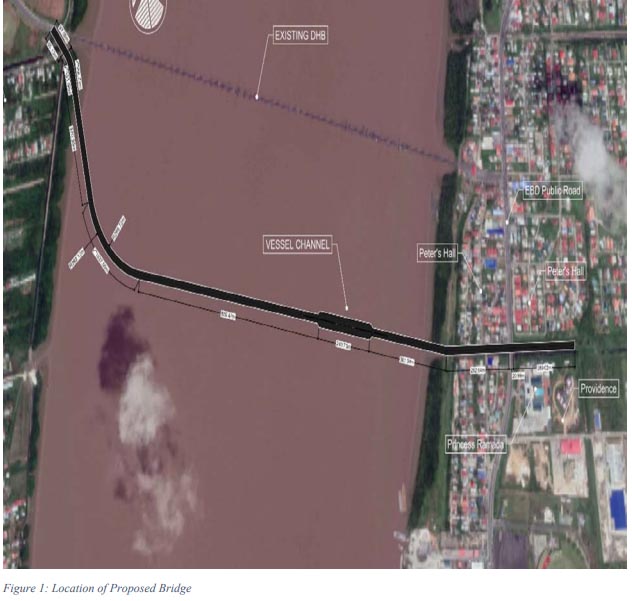-argues EIA necessary to determine risks
November 27 ,2021

With the Environmental Protection Agency (EPA) sticking by its decision to not require an Environmental Impact Assessment (EIA) for the new Demerara Harbour Bridge, environmentalist Simone Mangal-Joly is warning against the potential impacts that a project of such magnitude can bring.
On Wednesday, the EPA launched a fresh process for the approval of a new bridge over the Demerara River and stuck to its contentious stance that an EIA is not required, even though protected mangroves will have to be removed. Additionally, it granted a 30-day period for the public to appeal the decision before the Environmental Assessment Board.
The new bridge is expected to land in the vicinity of Nandy Park on the eastern side of the Demerara River and at La Grange/Meer-Zorgen on the West Bank. Based on the information provided, the bridge is expected to land some 700 metres inland from the eastern bank of the river and will be elevated 50 meters at the beginning of the channel – which is closer to the east bank. The descent is slated to be at a rate of 5 degrees.

The Scope of Works in the design/build contract included the complete design and construction of a two-lane dual (four-lane) carriageway, hybrid cable-stayed centre-span bridge with concrete box/T-beam girder approach bridge structures, and must include bridge collision protection, a navigation span to accommodate Handymax vessel navigation aids, lighting, signage, and all other ancillary works, an access road with a minimum of 50 meters up to abutments, toll-collection buildings and ancillary buildings on the West Bank of the Demerara River.
Government in early November announced that it will be engaging China State Construction Engineering Corporation (CSCEC) for the construction of the bridge since it had submitted the lowest responsive bid. CSCEC, in its tender document, pegged the cost for the construction of the bridge at US$256,638,289 and this is based on the Design, Build and Finance (DBF) option, or Design, Build, Finance, Operate and Maintain (DBFOM).
The government is yet to engage CSCEC and the company still has to accept the award. From all indications, this process is yet to commence and it therefore means that while there is an artist’s impression of what the bridge would look like, there is no actual design for the project as per the intended agreement with CSCEC.
On that note, Mangal-Joly opined that the EPA cannot decide whether or not an EIA is required for a project when the design does not yet exist.
“When the EPA gets an application for an environmental permit for a project, it must examine the project design and determine whether the proposed activities could have a significant impact on the environment and human health. If the impacts could be significant, then the EPA must require an Environmental Impact Assessment. To be able to determine whether an impact could be significant and thus require an Environmental Impact Assessment, the design of the structure must be known,” the environmentalist explained during an interview with the Stabroek News.
Hydrology of the Demerara River
The complete bridge project would have to be comprised of approach roads which must be built or rerouted in the communities to feed traffic to the bridge. Then there is the bridge approach, which is a type of ramp that leads up to the bridge and the upper structure one would drive over to get to the other side.
At both ends of a bridge are abutments, which are the parts that straddle the land and river and in between these in the river are piers, or big and wide posts that support the upper structure of a bridge.
Mangal-Joly, who holds a BA in Geology & Third World Development Studies from Smith College, USA, a Master’s in Natural Resources and Environmental Management with sub-specialisation in Social Ecology from Yale University, USA, and has completed three years of graduate field research on the Environmental Impact Assessments (EIA) in natural gas and downstream developments towards a PhD in Economic Anthropology at University College London, told this newspaper that the construction of the piers usually requires pile driving deep into the riverbed to provide the support for the bridge.
“This comes with its own risks due to vibration. There can be many impacts of a bridge, depending on the bridge design, or during construction and operation… the number of piers in the bridge design will determine the degree of obstruction of water flow. The degree of flow obstruction will tell you what to expect downstream. Basically, the number and positions of the piers will affect the hydrology of the river. One must conduct hydrological and hydraulic studies to determine the likely impacts and identify impacts that are significant enough to warrant a closer assessment of their specific nature, extent, and any measures to counteract or deal with the negative effects. To model and conduct hydrological studies you need a design for the bridge,” the geologist explained.
Further, the hydrological changes in the river can change how sediments are deposited downstream, affect the passage of boats, operation of wharves, affect the biology of the riverbed, the ecosystem of the riverine harbour, the fish and marine life, and affect fisheries and the livelihood of fisherfolk.
“In fact, the entire port of Georgetown could be silted by this bridge depending on the design,” she posited.
With reference to the US$600 million wharf project being executed by a group of local businessmen, Mangal-Joly said that she and her associates would be pushing to have an EIA conducted to determine the impact the project may have on their investment.
Impossible to justify waiving of EIA
The project would see the construction of an access road at Nandy Park, and according to Mangal-Joly, there may be an attempt to separate the roads from the bridge project. However, she warned that Guyana’s Environmental Protection Act does not allow for the separation, explaining that once something is required for the bridge to function then it is part of the “complete” project.
Approach roads will affect every person that operates within the area of the expected landing site of the bridge and the density of vehicular traffic will affect residents’ health, as there will be noxious fumes which can be very dangerous to one’s health at fine scales.
“One would have to model airflow and may want to alter the design to minimise harmful effects on residents. One can expect an increase in industrial usage, which means an increase in pollution over current levels. One can also expect the greater intensity of rainfall and propensity for landside floods and would have to account for how impacts could change over time based on climate models. The short is that it is impossible to justify waiving an EIA at this stage or waiving an EIA at all. That is an irresponsible thing to do,” she asserted.
The environmentalist added that waiving an EIA for a structure as massive as the new DHB project is unheard of in the democratic world. She explained that the EPA should wait on the preliminary bridge designs and launch the EIA process while the designs are being finalised. This would allow for the best possible design, as well as reduce delays, and it would not deprive the frontline communities of the opportunity to be part of the design process and to contribute to problem definition and solutions for minimising or mitigating impacts.
Additionally, the EIA and subsequent consultative processes would allow affected residents to be fairly compensated for their losses. The issue of consultation seems to be a burning one with the Regional Democratic Council of Region Four withholding its “no objection” to the project until the Ministry of Public Works holds consultative sessions with the residents of Nandy Park.
However, the Ministry has been silent on the holding those consultations.
Mangal-Joly said that it is her observation that the rush with the new DHB project seems to be aimed at enabling the activities of companies in the oil & gas industry and planned downstream activities rather than fixing the traffic problem.
“My understanding is that expert opinion on the traffic issue has to do with traffic control, not the capacity of the existing floating bridge. We are using public funds for a high span bridge and the least that the authorities can do is show some respect for the people’s wish to be included in a more meaningful way in the decisions that will profoundly affect their lives,” she added.
Appeal process
With the EPA allowing 30 days for persons to appeal the decision, Mangal-Joy said that going through the process again is tantamount to the EPA abusing citizens and its line staff. She was referencing the previous deadlines for filing appeals over the same decision.
Those hearings never kicked off and now the process is being restarted.
“We must stay vigilant as citizens against impatience and external influence that leads the Agency to make reckless decisions, such as waiving EIAs. We must keep holding the EPA accountable until those who would exert undue influence over it learn that the fastest way to get the job done is to do it the right way. This is in every Guyanese’s interest because we all rely on this agency to protect our communities, our businesses, our ecological and material assets which form our economic base, our very bodies, ourselves.
“Any Environmental Assessment Board hearing on the matter should not last for more than three minutes. There is no world in which anyone, at least any sane or self-respecting environmental professional, would show up in front of their peers to tell them how they decided to waive an EIA for a structure for which the design does not yet exist. If the EAB indulges this recent EPA decision, then in my view, each member of the EAB will have destroyed their own credibility,” she averred.
Mangal-Joly added that the EAB is fully aware that the job of an environmental regulatory agency is not to decide what it wants to do then bend the evidence around that action rather it is to look at the evidence and then decide what to do.
